 |
Aertsen, 1550: This could
be a jacket, or a doublet with the sleeves from an undergarment
(a gown, possibly) showing; or, the sleeves may be detachable. |
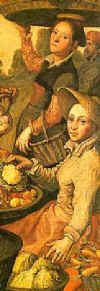 |
This woman's jacket latter
half of 16th century) has a stand-up collar and the sleeves are
turned back at the cuff. She has an apron over the bottom
of the jacket, so the lines can't be seen. |
 |
Flemish woman, second
half of 15th century
This jacket doesn't have a collar; the sleeves are rolled up. |
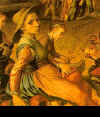 |
The woman in the background
appears to be wearing a jacket; the woman in the foreground is
wearing a bodice with sleeves pinned on. |
| 1600-1625 |
Norah Waugh, writing about
women's clothing during the period 1600 - 1625:
"Jackets, known as 'waistcoats' throughout the seventeenth
century, were informal wear for ladies of quality and the habitual
costume of other classes....
The basic cut is the same throughout. The two front pieces,
with centre front shaping, are joined to the back by two side
seams. The jacket is cut a few inches below waist level
to form a basque which is achieved by slitting the bottom and
inserting triangular gussets. In the earlier jackets the
back seams run from high in the armhole slightly in to the waist;
there is one gusset centre back, and two or more each side, set
to a low waist; usually there is a collar. The sleves are
cut from two similarly shaped pieces, straight to the elbow and
then curved forward to take the bend of the arm, with a front
seam set well forward and inserted at a point high into the armhole
The sleeves are wrist length, with a small cuff. Later jackets
follow the broader fashion line; that is, the shoulder seams widen,
and the back seams, set lower in the armhole, slope in and are
from two to three inches apart at waist level. The gussets
are set to the higher waistline, and the collar is ommitted.
The neckline may be quite high or very low." (Cut
of Women's Clothes, p. 25) |
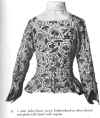 |
c. 1600 - a woman's jacket
from England, white linen with silk embroidery. (Victoria &
Albert Museum)
Another
embroidered jacket (1616) at the Metropolitan Museum of
Art
|
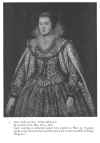 |
1607 - "Lady in Gray" |
 |
c. 1610 - Embroidered Jacket
(London Museum), Diagram II |
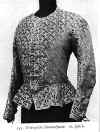
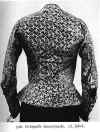
|
Kohler -- voided velvet
jacket, sometime in the 16th c. |
| 1625-1645 |
Basqued Bodice:
"Another style which developed in the late 1620's was a more
fashionable version of the jacket. Here again, the man's
doublet may have been the inspiration. The short high-waisted
bodice was cut like that of the new gown, but the skirt was replaced
by the basque. The basques varied. They might still
be cut like those of the embroidered jacket -- with triangular
gussets -- but more frequently they were made from several wedge-shaped
pieces called tabs, or tassets, with either hung separately
or were joined together. This bodice also was open in front,
the sides being pinned or laced across the stomacher. Sleeves
were very full, and were cut either in one straight piece, or
from two pieces slightly curved. In both cases the front
sleeve seam was placed well forward, and was inserted into the
bodice high in the armhole....
"In the 1630's a short bodice without basques was also worn.
The centre front was usually cut in one piece, without a stomacher
and with a very low neck and slightly pointed waist,. This
style as a rule had voluminous sleeves.
"This period had a very characteristic neckline. It
was cut very low and narrow in front, and the side pieces sloped
out to give a broad neckline. This, together with the wide shoulder
seams, large sleeves, epaulettes and high waistlines all emphasized
the fashionable trend towards breadth, which reached its peak
1630-1640. After 1630, there was no change in cut, there
was a lessening of the rigidity of construction. The boned
body was discarded, the boning being transferred to the lining
of the short bodice or shortgown. The stiffening from the
sleeves and stomacher was reduced. This was especially noticeable
in England, where the whole interpretation of the fashionable
silhouette was softer and more fluid." (Cut of Women's
Clothes, p. 28) |
 |
c. 1625-30 - Embroidered
Jacket (Victoria & Albert Museum) |
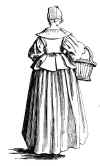 |
Callot, French dairymaid, c. 1625
One sees less fashionable women in Holland and England continuing
to wear the older longwaisted style through the 1640s, however.
|
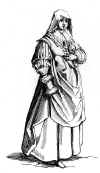 |
Callot, fashionable French
woman, 1630 |
 |
Wenceslas Hollar, 1639:
fashionable English women
|
| 1645
- 1680 |
Norah Waugh:
"By 1650, the waist was quite low and in order to balance
the design the tabs or basque became smaller. The stomacher
was still worn, but bodices with plain fronts were becoming more
usual. Although still cut on the same principles, these
longer bodices required more fitting. The back was shaped
as before with two side seams starting at the armhole, curving
to within an inch each side centre back and continuing in parallel
lines down to the waist. The front might be cut with a centre
front seam shaped in to the waist and with an underarm seam; more
frequently, this bodice also had two side front seams starting
from the armhole and curving over the bust to run in two parallel
lines ending in a blunt point which by 1660 was very long.
This cut also frequently had an underarm seam. The neckline
was now oval, running round the outside edge of the shoulders
straight across the back and dipping slightly in front...."
(Cut of Women's Clothes, p. 30)
"Some women adopted the man's doublet for riding.
When in the 1660's the man's riding coat was becoming fashionable
wear, women began to appear in it. It was worn for hunting
but also sometimes for travelling by coach." (Cut
of Women's Clothes, p. 31)
|
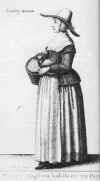 |
1643 -
Wenceslas Holler, ‘Mulier Anglica habitans in Pago’.
Country wife wearing linen coif, straw or felt hat, apron, jacket,
bodice, neck scarf or collar. |
 |
c. 1660 - Pink silk jacket,
embroidered with blue thread (Victoria & Albert Museum) |
| 1680
- 1720 |
Norah Waugh:
"The jacket, or waistcoat, with short basques, was too useful
a garment to be discarded and continued to be worn for negligée
wear and especially by working women. There were also simple
bodices, laced up centre back or perhaps crossing in front and
caught together centre front with bows. These were more
for casual wear and were habitual for children and young girls.
The riding coat was a replica of the man's coat, and was always
worn with cravat and cocked hat. It was frequently used
for travelling. (Cut of Women's Clothes, p,. 66) |
 |
Quilted jacket; green and
red floral patterns were woven into the fabric prior to quilting.
English, c. 1690, from Quilting by Averil Colby |
| 1720
- 1770 |
Norah Waugh:
"The riding coat continued to be based on the man's coat,
but in the 1740's, in order to allow for the riding hoop, the
front was cut separately and a basque was added. The back
was still cut in one, and was open from the waist, and there were
often pleats from the side seams. The casaqin was
now called a pet en l'air, and there were other jackets
for informal wear, some cut like the riding coat but with low
neck and short sleeves. There were also wrapping gowns,
some with loose fronts and fitted back like the mantua.
The bed-gown or countrywoman's three-quarter-length gown was what
is now called a dressing-gown. (Cut of Women's Clothes,
p. 70) |
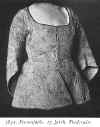
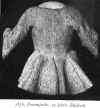
|
Kohler, women's jacket, probably early/mid 18th century
A similar jacket can be seen in Janet Arnold's Patterns
of Fashion, but with a slightly elevated waistline reflecting
a later date
|
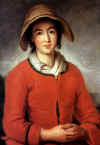 |
Elisabeth Oberbüchler, a refugee from Salzburg, by Pesne, 1732
This jacket has long sleeves and pockets; it is closer to what
English women were wearing as riding habits in the 18th century.
It may be a distinctly German style, but given the lack of pictoral
and other evidence, it's hard to say.
|
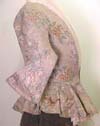 |
Jacket sold on Ebay, ca.
1740s-1750s; a similar jacket can be seen in Arnold's Patterns
of Fashion; click on picture to see more details |
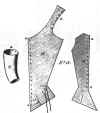 |
1769 - corset blanc
(white corset), from M. Garsault's Description des Arts et
Métiers
Waugh: "This is usually made in white linen and lined,
it is only boned each side of the centre front. The centre
back can be sewn together, or open and laced. The fronts
can be laced, buttoned, or tied with ribbon ties. The sleeve O
may either be sewn in, or just laced on top of the shoulder."
(Cut of Women's Clothes, p. 107)
This perhaps ought to be classified with corsets or stays,
not jackets, except that it has sleeves that tie on.
|
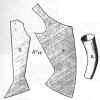 |
1769 - camisole
(Bed jacket). Waugh: "This is less fitting than a corset
and usually ties in front with ribbons. R is the sleeve."
This is likely an 'undress' garment -- something worn in one's
own home, not out in public.
|
 |
1769 - juste (jacket).
Waugh: "This is usually worn by countrywomen. The sides
are sewn down to the waist only, and then are left open to form
basques. The sleeves are either plain to the elbow, x,
or shorter, y, in which case a pleated frill, z,
is added. The jacket is lined and the edges bound with ribbon;
it fastens in front with ribbon ties." (Cut of Women's
Clothes, p. 109)
Broken
Eggs, 1756, by Jean Baptiste Greuze -- see the tied-on
sleeves worn by the older woman.
Le
Geste Napolitain, 1757, by Jean Baptiste Greuze -- again,
tied-on sleeves worn
|
 |
1769 - manteau-de-lit
(bed-gown). The sleeves are cut in one piece with the
body, and squares from the sides of the gown are added to the
sleeves for additional length. The squares of fabric at
the sides of the gown are folded to make an inverted pleat.
(Cut of Women's Clothes, p. 110)
Jackets worn by women in paintings by Chardin:
Grace
Before the Meal, 1744
Girl
Peeling Vegetables
The
Laundress, 1730s
Greuze, 'The
Wool Winder,' 1758-1759
Greuze, 'The
Laundress'
Lacroix' 'Street Cry' print: A Sweeper
|
| 1770-1800 |
Jackets in this period became shorter and more tightly fitted,
and often had long, tight sleeves.
|
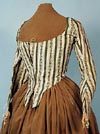 |
Pierrot
Jacket at the Met
1780s Jacket
or fitted bodice on Karen Augusta's web site; click on picture
to see more details |
|